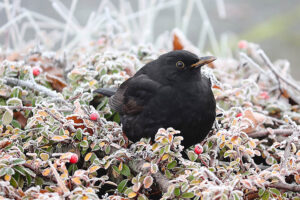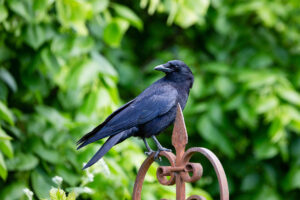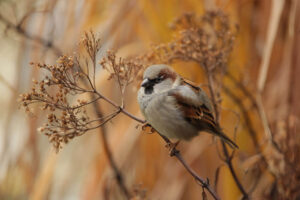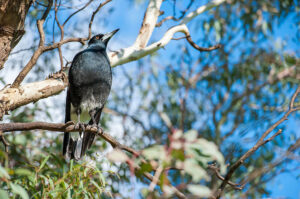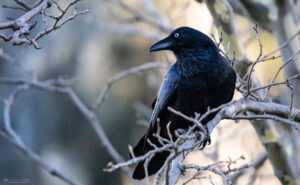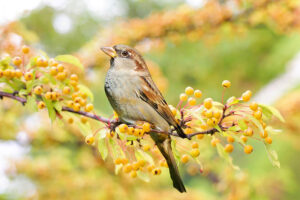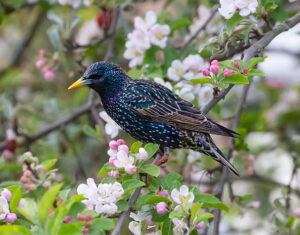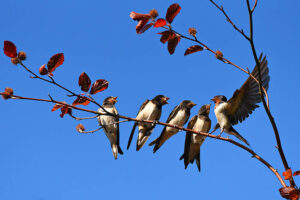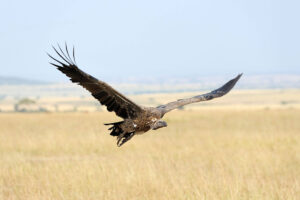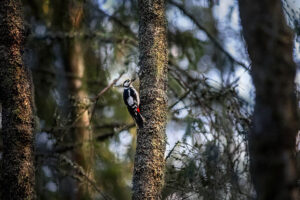Bird Control
Do you need to get rid of birds? We can help!
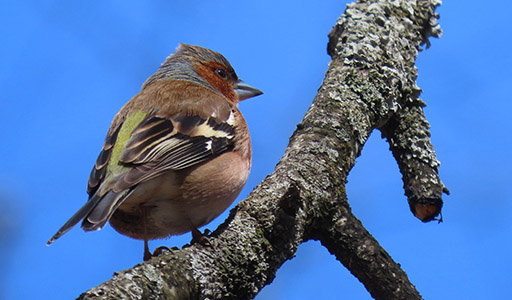
Bird Control Strategies
Bird Problem

Signs a Bird is on Your Property
They sing sweet songs and can fly hundreds of miles across the sky. But, birds are common critters across most of the United States. Because they are so prevalent, these creatures can create a real nuisance for homeowners like yourself. Birds are known to cause damage by building nests or leaving droppings in your home or attic. Birds can also carry insects like fleas, mites, and lice on their wings that can be spread if they make their way into your home. Once they have entered your home, these flying creatures can be difficult to get rid of. When you notice birds on your property or in your yard or garage, you know that it is time to call the wildlife management experts at Trutech.

Dangers of Bird Infestation
Common problems from nuisance birds include:
- Roosting or nesting around human habitations
- Diseases or ectoparasites affecting man including histoplasmosis and cryptococcosis
- Noise, droppings, odor, and feathers
- Unpleasant or hazardous working conditions
- Destroying vegetation and contaminating foods
- Feeding on agricultural products
Humane Bird Removal & Control Strategies

Entry into property
Favorable bird living conditions include prime nesting locations, cover from predators, abundance of food sources, and nearby water. As many residential areas offer most, if not all, of these features, birds frequently take up residence on private properties. House eaves, chimneys, gutters, and rooftops all serve as excellent nesting sites. It is rare for birds to enter buildings, and most avian home invasions occur when windows or doors are left open.

Trapping & Removal
Several options are available to mitigate bird issues. For residential structures, the focus is more on exclusion and prevention. For commercial locations where buildings can be vast, we may suggest different options due to the higher concentration of bird populations. In these cases, we may resort to installing netting, bird spikes, or optical gel.

Prevention & Exclusion
Various methods exist to deter birds from ruining crop productions. Farmers and gardeners can employ protective netting, which restricts unwanted bird pests’ access to crops. Frightening devices can be effective, as well. To inhibit bird activity around manmade structures, individuals can cover favorite roosting areas with spikes. Caution should be exercised in order to avoid legal repercussions as some species are protected under local, state, or federal laws.
Residential Bird Control
While birds do not intentionally fly inside houses, their nesting preferences can lead them indoors. Various species of birds, including European starlings, house sparrows, chimney swifts, and swallows, are enticed onto lawns by freshly spread grass seed, well-kept vegetable gardens, and fully stocked backyard birdfeeders. Once infestations become established outdoors, birds may start to seek the shelter of manmade buildings and find entry to homes through attics, vents, chimneys, and even open doors and windows.

SIGNS OF BIRDS IN THE HOME
As they are typically panicked and searching for a way back outside, birds in houses are easily detectable. Household residents may see them flying about or perched on furniture. Additionally, individuals might hear chirping, scratching, and the fluttering of beating wings. Wild birds that are unable to escape may die inside homes, which spreads foul smells as their bodies decompose. Infestations of birds in the house are also made apparent by the presence of excrement. As cities and suburban neighborhoods encroach on birds’ natural habitats, the pests must get creative in their nesting habits. Finding birds in attics has become remarkably common since these spaces provide the pests with shelter and seclusion. Species like sparrows, starlings, and pigeons can break into homes via holes three-fourths of an inch to two inches in diameter. Vents located near roofs, chimneys, windows without screens, and open doors are all common points of entry, as well.
Birds in Vents
Birds occasionally nest or get stuck in vents on the side of the house, kitchen and bathroom exhaust vents, or others. Vents are attractive locations for birds to build nests as they are off the ground, away from predators, and enclosed for protection from the elements. However, vents do come with their own set of dangers for young birds, which sometimes fall into the vent exhaust pipe, where they’re unable to escape.

SIGNS OF A BIRDS IN THE ATTIC
Birds in attics are easily identifiable. Home residents may notice birds flying into vents or gaps. Nests assembled of twigs, sticks, grass, and other plant materials may be spotted in rafters. Additionally, birds leave accumulations of droppings, which are malodorous. Both adult birds and chicks make a variety of sounds such as chirping, shuffling, and scratching. Finally, damage to attics, like insulation that’s been ripped from walls, can alert individuals to the presen
Birds on the Roof
Many species of birds establish nests or perches on the roofs of homes and businesses, compromising human health and undermining the structural integrity of buildings.
Soffits and house corners, places where the gutters meet and connect to downspouts, frequently attract birds as they are a source of fresh water. To prevent this, it’s important to maintain clean gutters and prevent clogs.
Nests built-in gutters cause issues with clogging and create fire hazards.
Birds in Chimneys
Some birds prefer to make their homes in hollow trees, and for these species, your chimney is an attractive place. One of the most prominent species is the swift family, which nest in the interiors of chimneys. While these nests aren’t a fire hazard, nests interrupt the airflow of smoke and carbon monoxide. Moreover, young birds may slip and fall out of chimneys into your home. Nests of baby birds inside chimneys will make audible rackets of chirping sounds as the hatchlings call to their mother.
Birds in Trees
Species of birds like owls, woodpeckers, swallows, and finches rely on trees for food and shelter.Trees are important sources of insects and nuts for insectivorous birds and provide hunting perches for carnivorous species. Hollow tree cavities and strong, supportive branches are where most birds build nests to raise their young. Unfortunately, some species roost in large enough flocks to damage trees and cause problems for property owners.
Commercial Bird Control
The best bird control for municipal and commercial buildings emphasizes deterrents, exclusion, or modification of buildings. When nuisance birds make your property their home, you need them gone – fast. Trutech® can help. Our professional technicians are experts at wildlife removal, control, and exclusion. All of our technicians are Trutech employees. All are licensed, insured, and OSHA-trained for your peace of mind.

Risks of Birds to Your Business
- Financial Risks Birds cause damage that can lead to costly repairs. /li>
- Compliance Risks Bird infestations can lead to failed health inspections to potential contamination.
- Public Health Risks Birds can spread over 60 diseases.
Commercial Industries Support
Bird Control for Grocery stores
Birds are drawn to grocery stores for a variety of reasons, but the primary attraction is food. With their keen eyesight, birds can see food from a distance. Seeking a meal, birds will enter the store through open doorways and can be trapped inside.
Grocery store receiving docks also provide an entry area for birds. Once inside, birds damage packaging, produce and bakery items, and defecate on products and people.
Bird Control for Manufacturers and Warehouses
Manufacturing and warehouses typically have large openings that birds can easily fly into.
Large man-made structures are prime locations for pigeons. Sparrows and starlings tend to nest in cavities, so any holes or crevices are attractive to them. Pigeons nesting on supports, ledges, and signage can become a serious inconvenience, as well as a health hazard for your employees.
Bird Control Shopping Centers
Pigeons nesting under building canopies, awning supports, façade signage, and architectural ledges can become a serious inconvenience, as well as a health hazard for your tenants and their customers.
Roof HVAC units often provide roosting and nesting spots for the birds, as well as access for the birds to enter the building. Once inside, the birds will contaminate the area above the commercial ceiling tiles, where they may go unnoticed for years, allowing large accumulations of their feces.
Bird Control in Hotels
Hotels and motels are often prime locations for pigeons, sparrows, and starlings.
Pigeons use a variety of habitats but are most common in and around urban areas or large man-made structures. Sparrows and starlings tend to nest in cavities, so any holes or crevices are attractive to them. This can become a serious inconvenience, as well as a health hazard. The longer the birds stay in the area, the more numerous they will become.
Frequently Asked Questions
Certain bird diseases can be caught by humans. While most do not pose a significant threat, some require medical intervention. The most common bird-transmitted infections include cryptococcosis, histoplasmosis, salmonellosis, and avian tuberculosis. Each of these diseases usually results from the feces of infected birds being ingested or inhaled.
Large groups of roosting birds leave an accumulation of smelly, messy droppings. This should concern homeowners, as the pests’ feces may carry dangerous pathogens. For instance, when inhaled, Histoplasma mold causes flu-like symptoms and can be fatal if untreated. Cryptococcosis, an illness caused similar to meningitis, is another fungal disease humans can catch from exposure to waste or old nests. Usually spread through contaminated food or water, avian tuberculosis can be debilitating to those with autoimmune deficiencies. Finally, food poisoning caused by salmonellosis is one of the more common diseases humans can catch from birds.
As they are typically panicked and searching for a way back outside, birds in houses are easily detectable. Household residents may see them flying about or perched on furniture. Additionally, individuals might hear chirping, scratching, and the fluttering of beating wings. Wild birds that are unable to escape may die inside homes, which spreads foul smells as their bodies decompose. Infestations of birds in the house are also made apparent by the presence of excrement
Birds in attics are easily identifiable. Home residents may notice the pests flying into vents or gaps. Nests assembled of twigs, sticks, grass, and other plant materials may be spotted in rafters. Additionally, birds leave accumulations of droppings, which are malodorous. Both adult birds and chicks make a variety of sounds such as chirping, shuffling, and scratching. Finally, damage to attics, like insulation that’s been ripped from walls, can alert individuals to the presence of birds in the attic.
Birds in trees leave signs of their presence, such as nests, droppings, and tree damage. Individuals may notice nests in hollow cavities, woven between branches, on the sides of trunks, or even suspended from branches. Though their appearance and size varies from species to species, bird nests are typically constructed of twigs, leaves, and strands of fiber. The presence of droppings on trunks, branches, and the ground underneath trees also indicates the existence active infestations. Other signs of birds in trees include holes pecked into trunks, broken branches, and nibbled fruits and nuts.
Many species of birds establish nests or perches on the roofs of homes and businesses, compromising human health and undermining the structural integrity of buildings. As birds collect in one place, so do their droppings, which are highly acidic and can eat through a variety of building materials. Bird excrement also causes injuries as accumulations make sidewalks slippery.
Additionally, the pests’ feces contribute to the spread of various diseases like Histoplasmosis. Nests built in gutters cause issues with clogging and create fire hazards. Furthermore, the excessive noise pollution that results from birds on the roof constantly chirping annoys and distracts building residents.
Most birds are protected. If there are no eggs or young present, then we can remove the nest and apply deterrent to discourage this behavior. If there are young and the species is protected, then we are legally forced to allow them to fledge. Once they have left, we can remove the nest, treat the area for ecto-parasites, and determine a solution to prevent this in the future.


